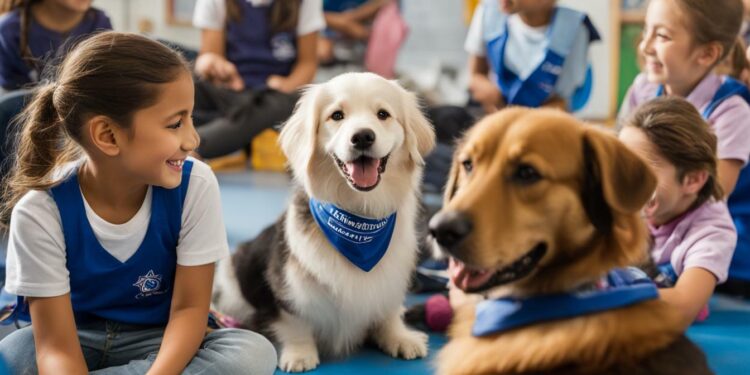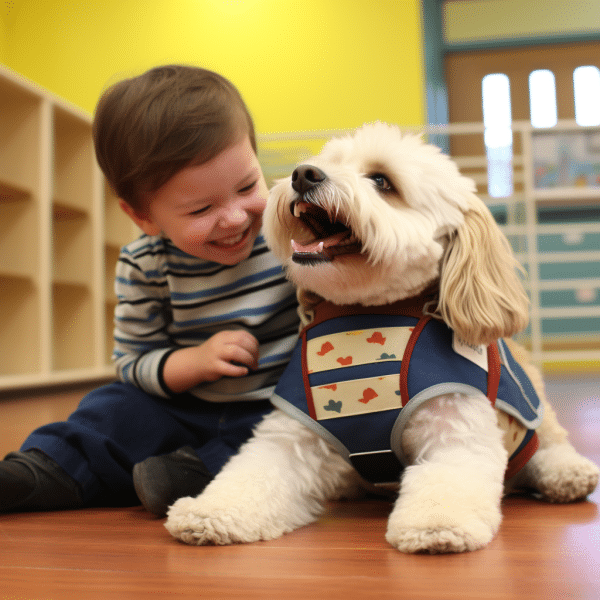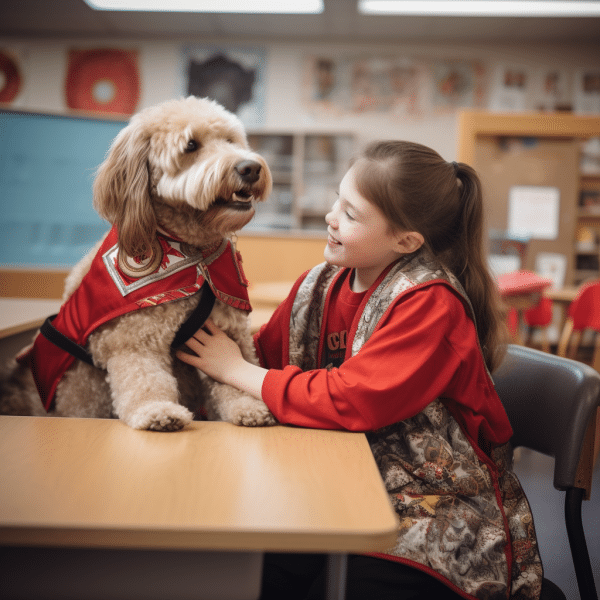Enhancing Education: School Therapy Dogs and Benefits

School Therapy Dogs: Therapy dogs in schools help with emotions, learning, and socializing. They are trained and popular in the US. There are different models for using therapy dogs in schools. To get a therapy dog team, contact therapy dog organizations. Therapy dogs are trained and tested to support students. If you want to buy a therapy dog, research first. School therapy dogs should live in a stable and nurturing environment. For insurance, check with educational institutions or professional organizations. To address allergies and fears of dogs, designate no-dog zones and put up signs.
If you’re interested in training your own therapy dog, it requires a significant commitment to attend training lessons and maintain a working partnership with your dog throughout their career. Dogs selected for therapy dog training should have a temperament suited for working with others in a complex school environment.
Schools are using therapy dogs more often due to COVID-19 to help with children’s mental health. These dogs provide communication, behavior, and emotional support. Proper training for therapy dogs and handlers is important for student safety. A school therapy dog program requires trained volunteer handlers who provide training, certification, and insurance. It is important to consider the well-being of therapy dogs and give them rest days and time to relax. On-site therapy dogs can be covered by professional organizations, school insurance plans, or handlers’ insurance.
The Three Models of Incorporating School Therapy Dogs

There are three different models for incorporating therapy dogs in schools, each with its own unique approach to providing support and enhancing the educational experience for students. These models are the visiting support model, the visiting AAI model, and the professional AAI model.
Therapy dogs and handlers visit schools regularly to provide emotional support to students. The dogs help to ease stress and anxiety and can be brought in as needed. This is known as the Animal-Assisted Intervention visiting model. The dogs participate in organized, human-led sessions with educational and therapeutic objectives. They work closely with teachers to help students with social skills and behavioral problems.
The professional AAI model involves a trained therapy dog accompanying a handler who already provides services to students, such as a school counselor or special education teacher. The therapy dog becomes an integral part of the professional’s work, offering emotional support and assisting in various activities. This model requires the handler to have expertise in both their profession and working with therapy dogs, ensuring a seamless integration of support for students.
| Model | Description |
|---|---|
| Visiting support model | Therapy dogs and their handlers make periodic visits to the school to provide emotional support to students. |
| Visiting AAI model | Therapy dogs participate in structured intervention sessions led by trained professionals. |
| Professional AAI model | A trained therapy dog accompanies a handler who already provides services to students. |
The Benefits of Incorporating Therapy Dogs in Schools
- Emotional Support: Therapy dogs have been found to reduce stress, improve mood, and increase overall well-being for students, creating a positive and supportive environment.
- Enhanced Learning: Interacting with therapy dogs can improve focus, attention, and motivation, leading to improved academic performance and engagement in the classroom.
- Social and Emotional Skills: Therapy dogs can help develop social and emotional skills in students, such as empathy, compassion, and effective communication.
- Behavioral Management: The presence of therapy dogs can help manage disruptive behaviors, promote self-regulation, and facilitate conflict resolution among students.
“Having therapy dogs in our school has made a significant difference in the lives of our students. They provide comfort, companionship, and a sense of belonging, helping our students to thrive both academically and emotionally.” – School Administrator
By incorporating therapy dogs in schools, educators and administrators can create a nurturing and inclusive environment that supports the holistic well-being of students. Whether through regular visits, structured intervention sessions, or integration into existing professional services, therapy dogs have the potential to make a positive impact on the educational journey of students.
Finding a Therapy Dog Team for Your School
Finding the right therapy dog team for your school can be done by reaching out to therapy dog organizations that maintain lists of dedicated volunteer teams. These organizations are committed to connecting schools with trained therapy dog teams that can provide emotional support and enhance learning for students.
The Role of Therapy Dog Organizations
Therapy dog organizations play a vital role in ensuring that therapy dog teams are qualified, reliable, and well-suited for the school environment. These organizations typically have rigorous screening processes in place to evaluate the dogs’ temperament, behavior, and training. They also assess the handlers’ experience and ability to effectively work with students.
Once a therapy dog team is approved by a therapy dog organization, they are added to a list of dedicated volunteer teams. Schools can then reach out to these organizations to find a suitable team that matches their specific needs. The organizations can provide information about the teams’ availability, experience, and any specialized training they may have.
| Benefits of therapy dog organizations: | Considerations when contacting organizations: |
|---|---|
|
|
“Therapy dog organizations are an invaluable resource for schools looking to incorporate therapy dogs into their programs. By connecting with these organizations, schools can access trained and qualified therapy dog teams that can positively impact the well-being and learning experience of students.”
When contacting therapy dog organizations, it’s important for schools to clearly communicate their requirements and expectations. This includes discussing any specific needs or considerations related to the student population, such as allergies or fears of dogs. Additionally, schools can inquire about the training and certification process that therapy dog teams have undergone to ensure they meet the necessary standards.
Therapy Dog Teams
Choosing a reputable and well-established therapy dog organization is essential for ensuring the quality and reliability of the therapy dog team. Schools should look for organizations with a track record of success, positive testimonials, and a commitment to maintaining high standards of training and behavior for their therapy dog teams.
By collaborating with therapy dog organizations, schools can find suitable therapy dog teams that can provide valuable emotional support and enhance the educational experience for students. These organizations play a critical role in vetting and connecting qualified therapy dog teams, ensuring schools can confidently incorporate therapy dogs into their programs.
Qualifications for School Therapy Dogs
Therapy dogs need training and evaluation for educational use. Help should be psychological and educational. They learn to behave in noisy, crowded places and recognize and respond to others’ feelings. They must be able to handle a diverse instructional environment with many potential disturbances. Competency assessments may assess their obedience, flexibility, and stress management. Therapy dogs may comfort pupils, stay calm under pressure, and behave correctly with instructors, other animals, and the public, according to these reviews.
Considerations When Purchasing a Trained Therapy Dog
When purchasing a trained therapy dog, it is important to conduct thorough research, as there are no standardized requirements for training or certification. To ensure you select the right therapy dog for your school, consider the following factors:
- Temperament: Therapy dogs need to have a calm and gentle temperament, as they will be working closely with students who may have anxiety or other emotional needs. Look for dogs that are naturally friendly, patient, and adaptable.
- Training: While there may not be standardized requirements, it is still important to evaluate the training the dog has received. A well-trained therapy dog should be able to respond to basic commands, exhibit good manners, and remain calm in various situations.
- Experience: Consider the dog’s experience working with children and in educational settings.
- Health and Vaccinations: Ensure that the therapy dog you are considering is in good health and up to date on all vaccinations. Regular veterinary check-ups and preventive care are essential to maintain the well-being of the therapy dog and ensure the safety of students and staff.
To find the right therapy dog for your institution, you should consider certain factors. The dog must have the right temperament and experience to be an emotional support and learning partner for children. Additionally, the dog must be trained and certified for this purpose.
The Importance of Standards and Certifications
No national or international laws govern therapy dog training and certification. However, independent certification programs ensure therapy dogs are qualified before entering a classroom.
“When purchasing a trained therapy dog, it is important to conduct thorough research, as there are no standardized requirements for training or certification.”
The dog is evaluated based on its behavior, following commands, and awareness. Both the dog and owner may need further training. Certification for therapy dogs is optional, but it ensures that they have been properly evaluated. The certification group can provide assistance.
| Certification Organization | Website |
|---|---|
| Therapy Dogs International (TDI) | www.tdi-dog.org |
| Alliance of Therapy Dogs (ATD) | www.therapydogs.com |
| Association of Professional Dog Trainers (APDT) | www.apdt.com |
Quotes:
To make a good choice when buying a therapy dog for your school, consider these factors. Certification isn’t required, but it can give you confidence in the dog’s quality. Look for a dog with the right temperament, training, experience, and health.
Conduct thorough research and consider certification programs offered by reputable organizations to ensure you select the best therapy dog for your school’s needs.
Providing a Suitable Living Situation for School Therapy Dogs
School therapy dogs need a stable home to stay healthy and happy. They help students with their emotions and learning, so where they live is important.
Therapy dogs need a stable and consistent environment for their well-being. Living with a single family provides individual attention, care, and training, avoiding conflicts and stress. A peaceful home helps dogs recharge after working in high sensory environments, like schools. This prevents overstimulation and burnout, enabling them to provide the best emotional support.
School therapy dogs need exercise, mental stimulation, and socialization. They can go on walks, play, and interact with others. These activities keep them physically and mentally healthy.
| Benefits of a Single Family Living Situation for School Therapy Dogs |
|---|
| 1. Enables individual attention, care, and training |
| 2. Helps maintain behavioral and emotional health |
| 3. Prevents conflicts and stress from multi-dog or multi-family households |
| 4. Allows therapy dogs to recharge and relax after high sensory interactions at school |
| 5. Supports their physical exercise, mental stimulation, and socialization needs |
School therapy dogs need a steady setting. Therapy dogs thrive in single-family homes due to their personalized attention. This tranquil hideaway can prevent overstimulation fatigue. Prioritizing therapy dog care helps schools provide emotional support and educational possibilities.
Liability Insurance for Therapy Dog Teams
Therapy dog teams should be covered for school accidents. Therapy dogs and people sometimes have bad encounters. Colleges and professional organizations offer insurance. Finding affordable and comprehensive school insurance requires cooperation.
Therapy dog teams need liability insurance. Policies differ in coverage, limitations, events, and exclusions. Consider reading the fine print of policies to ensure team safety. The security of insurance lets teams function without interruption.
Liability Insurance for Therapy Dog Teams: A Summary
- Most educational institutions require therapy dog teams to have liability insurance to mitigate potential risks.
- Liability insurance can be obtained through school insurance plans, handlers’ insurance, or professional organizations.
- Therapy dog teams should research and choose the most suitable insurance option that meets their school’s requirements.
- Understanding the coverage provided, including limits, types of incidents, and any exclusions, is crucial.
- Having liability insurance provides peace of mind and allows therapy dog teams to focus on their important work.
| Key Points | Details |
|---|---|
| Requirement | Most educational institutions require therapy dog teams to have liability insurance. |
| Options | Insurance can be obtained through school insurance plans, handlers’ insurance, or professional organizations. |
| Coverage | Review policy details to understand coverage limits, types of incidents covered, and any exclusions. |
Addressing Allergies and Fears of Dogs in Schools
Allergies and fears of dogs can be addressed in schools by designating specific areas where therapy dogs are not allowed and ensuring the proper use of signage. These measures are crucial to create a safe and inclusive environment for all students.
Creating designated dog-free zones within the school premises is essential for students who have allergies or are afraid of dogs. These areas can include classrooms, libraries, and other spaces where therapy dogs are not required to be present. By clearly identifying and marking these areas, students with allergies or fears can navigate the school without encountering therapy dogs.
Appropriate signage plays a vital role in communicating the presence and boundaries of therapy dogs in schools. Clear and concise signs placed at entrances and in relevant areas notify students, staff, and visitors about the presence of therapy dogs and remind them to exercise caution.
Schools must also educate students and staff about therapy dogs. Educational campaigns and hands-on workshops can help students appreciate therapy dogs in the classroom.
The Benefits of Designated Areas and Appropriate Signage
| Benefits | Explanation |
|---|---|
| Ensuring student safety | Designated areas and signage help prevent accidental exposure to therapy dogs, which is crucial for students with allergies or fear of dogs. |
| Promoting inclusion | By creating dog-free zones, schools ensure that all students can participate in activities without fear or discomfort. |
| Reducing anxiety | Students who are afraid of dogs can feel at ease knowing that there are spaces where they will not encounter therapy dogs. |
| Clear communication | Appropriate signage provides clear information to students, staff, and visitors about the presence and boundaries of therapy dogs in the school. |
By implementing these measures, schools can address allergies and fears of dogs effectively, ensuring a positive and inclusive environment for all students.
Training Your Own Therapy Dog
To train a therapy dog, you must dedicate yourself and work hard with your dog. This helps the dog support kids emotionally and academically. The training program includes discipline, social skills, and emotional regulation. It also improves your communication and crisis management skills. To succeed, you need a strong bond with your dog. Trust and understanding expectations are important, and praise and consistency help establish a stable bond.
| Training Tips for Developing a Strong Partnership: |
|---|
| 1. Practice regular training sessions to reinforce commands and behaviors. |
| 2. Offer rewards and positive reinforcement for desired behaviors. |
| 3. Create a calm and supportive environment for your dog’s training. |
| 4. Stay patient and consistent throughout the training process. |
Training a therapy dog takes time, patience, and dedication. If you put in the effort, you can create a strong partnership that benefits everyone involved.
Selecting Dogs for Therapy Dog Training
Therapy dogs in schools should be polite and calm. When choosing a dog, consider your lifestyle and their activity level. Although larger dogs are usually friendlier, city dwellers prefer smaller dogs. Any dog can be a therapy animal with proper training and temperament.
Dog’s Social Skills
To train a therapy dog, the first step is to evaluate their personality and obedience. A specialist can determine if they are suitable for a career in therapy.
| Considerations for Selecting Dogs for Therapy Dog Training |
|---|
| Temperament: Dogs should have a calm, friendly, and adaptable temperament. |
| Size and Energy Level: Consider the dog’s size and energy level to ensure they can comfortably navigate the school environment. |
| Social Skills and Obedience: Dogs should be well-socialized and responsive to basic commands. |
| Breed Characteristics: Therapy dogs don’t have to be a specific breed. Any dog can be a therapy dog with the right attitude and training. Some breeds may have certain qualities that make them good for therapy work. |
It’s important to think about the dog and the students. Choosing the right therapy dog is crucial. This will make sure that the therapy program is successful and positive for everyone involved.
Therapy Dogs in Response to the Youth Mental Health Crisis
More schools are using therapy dogs to help students cope with COVID-19’s impact on their mental health. The dogs help students relax, make friends, and improve their academic performance. They also aid emotional well-being by reducing stress, worry, and isolation. Studies have shown that therapy dogs can decrease cortisol levels and increase happiness. By having therapy dogs in the classroom, students can have a more lively and engaging learning environment. In the face of the pandemic, therapy dogs can help students build resilience and counteract the negative effects of excessive screen time on mental health.
| Benefits of Therapy Dogs in Schools: |
|---|
| Reduction of stress and anxiety levels |
| Promotion of emotional well-being and a positive school climate |
| Enhancement of social skills and communication |
| Improved focus and motivation for learning |
| Support for students with special needs or disabilities |
With the juvenile mental health epidemic growing, schools must prioritize student well-being. Therapy dogs in schools can improve students’ emotional health and academic performance. These four-legged buddies foster acceptance, understanding, and emotional growth via their unconditional love and support.
Integrating Therapy Dogs into Academic Work
Therapy dogs can aid academics by teaching communication and supporting behavior management. They soothe students and lessen stress, leading to improved learning. Reading to therapy dogs boosts reading fluency, confidence, and enjoyment of books. This results in better engagement, comprehension, and academic achievement.
| Benefits of Integrating Therapy Dogs into Academic Work |
|---|
| Enhanced student motivation and engagement |
| Improved reading fluency and comprehension |
| Increased social and emotional skills |
| Reduced behavioral issues and stress levels |
Therapy dogs help students with school work like writing, presenting, and group projects. They encourage teamwork, communication, and kindness. Students can learn to listen and show compassion. Therapy dogs make the classroom feel comfortable and safe. Teachers, handlers, and leaders work together to keep everyone safe. Therapy dogs help students learn and grow.
Training Programs for Therapy Dogs and Handlers
Therapy dog training takes commitment. This helps the dog develop and support kids emotionally and academically.
Therapy dog training begins with a solid curriculum. The curriculum stresses discipline, socialization, and emotional regulation. They improve handlers’ communication and crisis management. You need a good dog bond to succeed. Understanding expectations and trust are crucial. Praise and consistency build trust and stability with your dog.
Benefits of Reputable Training Programs
Enrolling in a good training program for therapy dogs and handlers has many benefits. These programs have a structured and comprehensive curriculum that addresses the specific needs and challenges of working in a school environment. They prepare therapy dogs to fulfill their role as emotional support providers and learning facilitators.
Top colleges prioritize therapy dog training. Animal handlers adapt to stress and fatigue. This helps dog workers stay happy and healthy. Professors value dog and trainer work higher.
Table: Comparison of Reputable Training Programs
| Training Program | Accreditation | Certification | Duration |
|---|---|---|---|
| ABC Therapy Dog Certification Program | Accredited by the American Kennel Club (AKC) | Certification upon completion of program requirements | 12 weeks |
| Pawsitive Paws Therapy Dog Training | Endorsed by Therapy Dogs International (TDI) | Certification exam conducted by TDI | 8 weeks |
| Canine Companions for Independence | Accredited by Assistance Dogs International (ADI) | Certification after successful evaluation by Canine Companions for Independence | 18 months |
It is important to research and compare different training programs to ensure that they align with the specific needs and goals of your school therapy dog program. By investing in reputable and well-developed training programs, you can enhance the impact of therapy dogs in providing emotional support and fostering a positive learning environment for students.
Launching a School Therapy Dog Program
Schools need volunteers with training, certification, and insurance expertise to start therapy dog programs. Without volunteers like these, school therapy dog teams can’t function or endure as long. Have someone who has handled therapy dogs handle the pups. Dog and students will benefit from these mentors.
Good training programs prepare dogs and handlers to support students’ emotional well-being.
Insurance is important for school therapy dog programs. Look into insurance options for on-site therapy dogs through professional organizations, school insurance plans, or handlers’ insurance. Insurance coverage protects therapy dog teams and handles unexpected incidents quickly.
| Key Steps for Launching a School Therapy Dog Program: |
|---|
| Coordinate with trained volunteer handlers for training, certification, and insurance |
| Ensure handlers have experience working with therapy dogs |
| Enroll handlers and dogs in reputable and well-developed training programs |
| Explore options for obtaining insurance coverage for on-site therapy dogs |
To start a school therapy dog program, work with trained volunteers. This can help students feel better emotionally and improve their well-being. Follow the steps closely for success.

Conclusion
There are three main models for incorporating therapy dogs in schools. The visiting support model involves therapy dogs visiting the school on a regular basis to interact with students. The visiting AAI (Animal-Assisted Interventions) model incorporates therapy dogs into specific educational programs. The professional AAI model entails a trained therapy dog accompanying a handler who already provides services to students. Each model has its own benefits and requirements, and the choice depends on the needs and resources of the school.
To get a therapy dog for your school, contact therapy dog organizations for a list of certified volunteer teams. Choose a team that meets your school’s requirements and has experience. If you want to buy or train a therapy dog, research to find one with the right temperament for school work. Provide a good home for your therapy dog. Schools need insurance for therapy dog teams and designated areas without therapy dogs for those with allergies or fears. Therapy dogs can improve communication, and behavior, and create a positive learning environment. Training programs for handlers and therapy dogs are crucial for success. Schools need trained volunteer handlers for certification, training, and insurance. Therapy dogs can benefit students’ emotional well-being and learning. Therapy dogs need training and guidelines.
FAQ
Q: What are the three models of incorporating school therapy dogs?
A: The three models are the visiting support model, the visiting AAI model, and the professional AAI model.
Q: How can I find a therapy dog team for my school?
A: You can find a therapy dog team through therapy dog organizations that maintain lists of volunteer teams.
Q: Where should school therapy dogs live?
A: School therapy dogs should have a single family living situation to prioritize their welfare.
Q: Do therapy dog teams need liability insurance?
A: Yes, most educational institutions require therapy dog teams to have liability insurance.
Q: Can I train my own therapy dog?
A: Yes, training your own therapy dog requires commitment to attending dog training lessons and regularly practicing and maintaining the working partnership throughout the dog’s career.
Q: What kind of dogs are suitable for therapy dog training?
A: Dogs selected for therapy dog training should have a temperament suited for working with others in a complex environment.
Q: Why are therapy dogs increasingly being used in schools?
A: The use of therapy dogs in schools has grown in response to the youth mental health crisis exacerbated by the COVID-19 pandemic.
Q: How can therapy dogs be integrated into academic work?
A: Therapy dogs can be integrated into academic work to teach communication skills and behavioral management.
Q: Where should I seek out reputable training programs for therapy dogs and handlers?
A: It is recommended to seek out reputable and well-developed training programs for therapy dogs and their handlers.
Q: What steps are involved in launching a school therapy dog program?
A: Launching a school therapy dog program requires coordination with trained volunteer handlers who can provide training, certification, and insurance.
Q: Can therapy dogs become overwhelmed in a school environment?
A: Yes, therapy dogs should be given rest days and time to relax in the high sensory environment of a school to ensure their well-being.
Q: How can insurance for on-site therapy dogs in schools be obtained?
A: Insurance for on-site therapy dogs can be obtained through professional organizations, existing school insurance plans, or handlers’ insurance.




